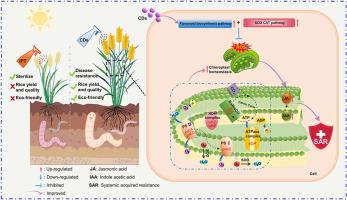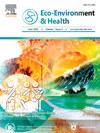Carbon dots as a green alternative for preventing Magnaporthe oryzae infection in rice: Mechanisms of disease resistance
IF 17.6
引用次数: 0
Abstract
The current study investigates the potential of carbon dots (CDs) as an eco-friendly “plant vaccine” for controlling rice blast disease caused by Magnaporthe oryzae. These CDs offer a promising alternative to commercial fungicides that threaten environmental and human health. Foliar application of CDs (at 100 and 200 mg/L) at the tillering stage enhanced rice blast resistance across the entire life cycle. CDs significantly reduced the leaf blast disease index, with infection rates of 30.8%–49.5%, outperforming the commercial fungicide isoprothiolane (57.3%). CDs significantly increased grain yield (186%–198%), starch content in grains (27.0%–27.5%), and protein content in grains (25.4%–36.1%) relative to infected controls. Moreover, CDs demonstrated lower toxicity to soil organisms (Eisenia fetida and Caenorhabditis elegans) than isoprothiolane. Mechanistically, CDs stabilized chloroplast homeostasis, amplified photosynthesis, and enhanced carbohydrate allocation, thereby synchronously activating systemic resistance through indole acetic and jasmonic acid signaling. These dual agricultural and environmental benefits position CDs as a sustainable crop protection strategy, reconciling food security with ecological safety.

碳点作为预防水稻稻瘟病菌侵染的绿色替代品:抗病机制
目前的这项研究调查了碳点(cd)作为一种生态友好的“植物疫苗”控制稻瘟病的潜力。这些cd为威胁环境和人类健康的商业杀菌剂提供了一个有希望的替代品。分蘖期叶面施用cd(100和200 mg/L)增强了水稻全生命周期的抗稻瘟病能力。cd显著降低了叶瘟病指数,侵染率为30.8% ~ 49.5%,优于市售杀菌剂异丙硫烷(57.3%)。与对照相比,cd显著提高了籽粒产量(186% ~ 198%)、籽粒淀粉含量(27.0% ~ 27.5%)和籽粒蛋白质含量(25.4% ~ 36.1%)。此外,CDs对土壤生物(臭Eisenia fetida和秀丽隐杆线虫)的毒性比异丙硫烷低。从机制上看,CDs稳定了叶绿体稳态,放大了光合作用,增强了碳水化合物分配,从而通过吲哚乙酸和茉莉酸信号同步激活系统抗性。这些农业和环境的双重效益使CDs成为一种可持续的作物保护战略,调和了粮食安全和生态安全。
本文章由计算机程序翻译,如有差异,请以英文原文为准。
求助全文
约1分钟内获得全文
求助全文
来源期刊

Eco-Environment & Health
环境科学与生态学-生态、环境与健康
CiteScore
11.00
自引率
0.00%
发文量
18
审稿时长
22 days
期刊介绍:
Eco-Environment & Health (EEH) is an international and multidisciplinary peer-reviewed journal designed for publications on the frontiers of the ecology, environment and health as well as their related disciplines. EEH focuses on the concept of “One Health” to promote green and sustainable development, dealing with the interactions among ecology, environment and health, and the underlying mechanisms and interventions. Our mission is to be one of the most important flagship journals in the field of environmental health.
Scopes
EEH covers a variety of research areas, including but not limited to ecology and biodiversity conservation, environmental behaviors and bioprocesses of emerging contaminants, human exposure and health effects, and evaluation, management and regulation of environmental risks. The key topics of EEH include:
1) Ecology and Biodiversity Conservation
Biodiversity
Ecological restoration
Ecological safety
Protected area
2) Environmental and Biological Fate of Emerging Contaminants
Environmental behaviors
Environmental processes
Environmental microbiology
3) Human Exposure and Health Effects
Environmental toxicology
Environmental epidemiology
Environmental health risk
Food safety
4) Evaluation, Management and Regulation of Environmental Risks
Chemical safety
Environmental policy
Health policy
Health economics
Environmental remediation
 求助内容:
求助内容: 应助结果提醒方式:
应助结果提醒方式:


